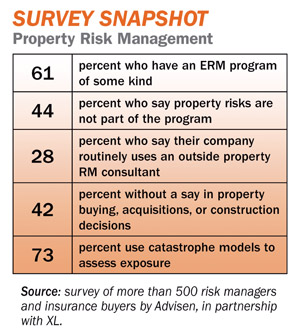A majority of organizations have an enterprise risk management program but a “surprisingly large minority” of these programs do not include property risks.
According to a survey by Advisen, done in partnership with XL, 61 percent of the 507 risk managers and insurance buyers who took part say ERM program are in place at their organization but 44 percent the program exclude property. The results “[call] into question the enterprise-wide scope of these programs,” says a report of the results.
Additionally, 42 percent of risk professionals say they aren't involved in decisions their company makes regarding building acquisitions or construction—though 54 percent say there is someone within the company devoted to or substantially responsible for property risk.
Recommended For You
Want to continue reading?
Become a Free PropertyCasualty360 Digital Reader
Your access to unlimited PropertyCasualty360 content isn’t changing.
Once you are an ALM digital member, you’ll receive:
- Breaking insurance news and analysis, on-site and via our newsletters and custom alerts
- Weekly Insurance Speak podcast featuring exclusive interviews with industry leaders
- Educational webcasts, white papers, and ebooks from industry thought leaders
- Critical converage of the employee benefits and financial advisory markets on our other ALM sites, BenefitsPRO and ThinkAdvisor
Already have an account? Sign In Now
© Touchpoint Markets, All Rights Reserved. Request academic re-use from www.copyright.com. All other uses, submit a request to [email protected]. For more inforrmation visit Asset & Logo Licensing.







